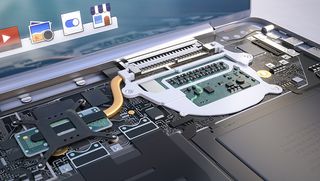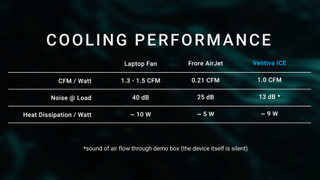Ventiva's Ionic Cooling Engine has no fans but is quieter, higher performance, and more efficient than Frore AirJet according to TechTuber teaser
Rival solid-state cooling solution has gotten Dave2D excited.

Tech enthusiast Dave2D has drawn the IT community's attention to an intriguing up-and-coming laptop cooler company, Ventiva. Through its Ionic Cooling Engine (ICE) solid-state cooling technology, Ventiiva could be set to revolutionize laptop cooling, and early testing results shared by Dave2D seem extremely promising. Like other solid-state coolers (which are a pre-existing technology but incredibly limited in application for reasons soon to become clear), Ventiva uses ionic thrusters to repel heat/push "air" without the use of a fan's moving parts with its ICE solid-state cooling technology.
The major issue with ionic coolers, and why they haven't seen widespread adoption before now, is that they're much more fragile to dust and debris than regular old fans are. While fans can obviously be hampered by dust, ionic coolers can be completely disrupted even by small amounts of foreign material, making them remarkably difficult to use for long-term scenarios, especially when existing fan-based coolers are so much cheaper and reliable.
That said, Ventiva also claims to have met and overcome these issues, though the specifics of how are apparently too patented to share with Dave2D or the wider public. Its official About page assures that all of its products are validated for "Pressure & Flow Generated (CFM)", "Silence (dbA, noise levels)", "RFI / EMI Immunity", "Humidity & Dust Immunity", and "In-System Lifespan".
These claims are given further weight by both a privately shown test unit laptop that Dave2D witnessed using a Ventiva cooler and a test box used in the video. Dave noted that while the demo laptop was apparently performing quite well with it, the far different nature of these cooling designs will require more custom laptop building work to make the real potential of solid-state laptop cooling come to light and offset its static pressure weaknesses.

In terms of raw cooling performance and noise levels, though, the Ventiva ICE certainly seems to have potential. Please reference the table above to gain insight into Ventiva's qualities and strengths.
We will ultimately have to wait and see if laptop manufacturers step up to the plate to build around this technology — and this technology in more retail products — to truly determine its value, though. The idea of a future with truly silent or near-silent (in the case of the hybrid designs) solid-state laptop cooling certainly intrigues, but we aren't quite there yet. However, Dave2D hints that we will see an important Ventiva partner emerge at CES 2025.
Stay On the Cutting Edge: Get the Tom's Hardware Newsletter
Get Tom's Hardware's best news and in-depth reviews, straight to your inbox.

Christopher Harper has been a successful freelance tech writer specializing in PC hardware and gaming since 2015, and ghostwrote for various B2B clients in High School before that. Outside of work, Christopher is best known to friends and rivals as an active competitive player in various eSports (particularly fighting games and arena shooters) and a purveyor of music ranging from Jimi Hendrix to Killer Mike to the Sonic Adventure 2 soundtrack.
-
Notton Ionic air movers have more problems than that.Reply
They literally ionized the air and produce ozone. The ozone and ionized air gives everything it touches a static charge that builds up.
While the ozone is unlikely to be a huge issue in a small device, the static charge build up is undesirable for sensitive electronics.
I had an indoor ionic air filter in the past. It was shocking everything down wind from it. -
Giroro "the specifics of how are apparently too patented to share with Dave2D or the wider public. "Reply
That's not how patents work.
Also "TechTuber" is synonymous with paid shill. That's the entire business model. So you should believe a TechTuber's claims in the same way you believe Mr.T's opinions on connection ovens. -
bit_user Reply
I immediately had this thought. I was wondering if they figured out some way to neutralize most of the air before it leaves the cooler or maybe you need like grounded, fine metal screens on the laptop's exhaust ports.Notton said:Ionic air movers have more problems than that.
They literally ionized the air and produce ozone. The ozone and ionized air gives everything it touches a static charge that builds up.
While the ozone is unlikely to be a huge issue in a small device, the static charge build up is undesirable for sensitive electronics.
I had an indoor ionic air filter in the past. It was shocking everything down wind from it. -
Unolocogringo My experience with Ionizers/ ozone generators is they lose airflow quite easily as the generator plates become dirty........Reply
Then it is dissemble and clean with pure alcohol or electrical parts cleaner.
Call me unimpressed with this new tech. -
Pierce2623 Reply
It did specifically say they had patents dealing with the traditional problems of dust and ionic air movers. And they claim to have some industrial rating for dust imperviousness. That being said, yeah, dust shuts em down real quick.Unolocogringo said:My experience with Ionizers/ ozone generators is they lose airflow quite easily as the generator plates become dirty........
Then it is dissemble and clean with pure alcohol or electrical parts cleaner.
Call me unimpressed with this new tech. -
JTWrenn After watching that video I feel like the frore tech actually has better use cases especially based on the pressure. I think coming up with ways to make it more energy efficient sound long term better than the dusk, ionization, and low pressure of the other device.Reply
They likely will each find their own use cases down the road...maybe even some kind of dual usage in some cases.
He also skipped over the fact that frore is meant to be direct attached a lot of the time. So it wouldn't be frore, then head sink...the frore is right on what it is trying to cool so it passes air right over it.
Will be interesting to see all the real world applications and what pans out. I would be pretty scared to put an o3 generator in my electronics though. -
JTWrenn Reply
They do say in the video that they use a coating on the fins of the heat sink to do that but...that just sounds like too many work arounds to me. Who knows, maybe it will be great, and the whole idea of solid state is cool, but I didn't see anything about dealing with build up...it's secret? Real world long term testing in semi dusty environments will tell the details.bit_user said:I immediately had this thought. I was wondering if they figured out some way to neutralize most of the air before it leaves the cooler or maybe you need like grounded, fine metal screens on the laptop's exhaust ports.
Most Popular





